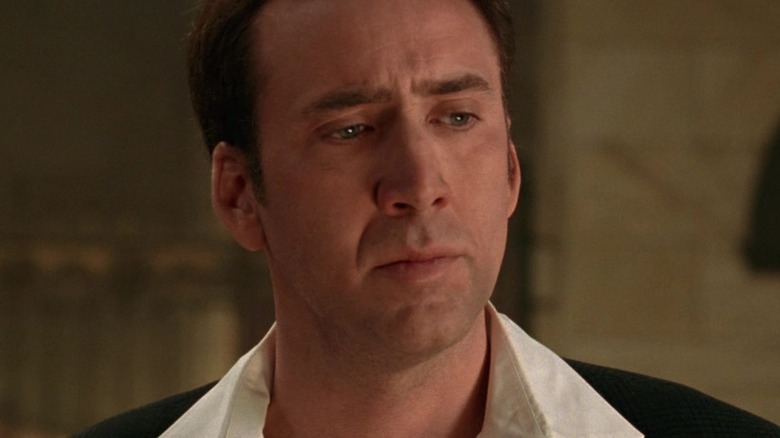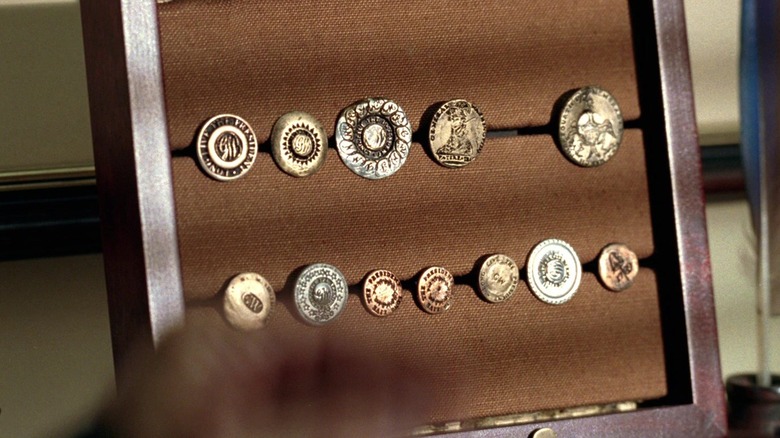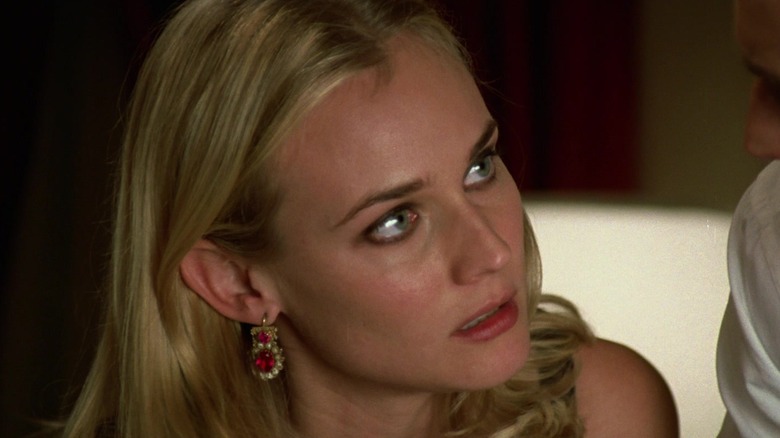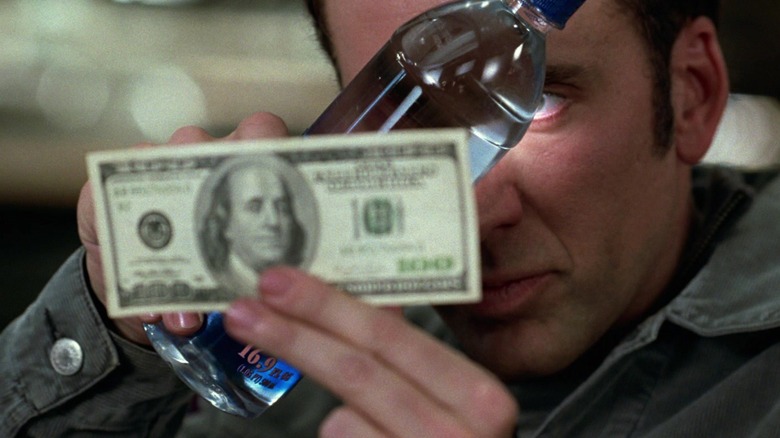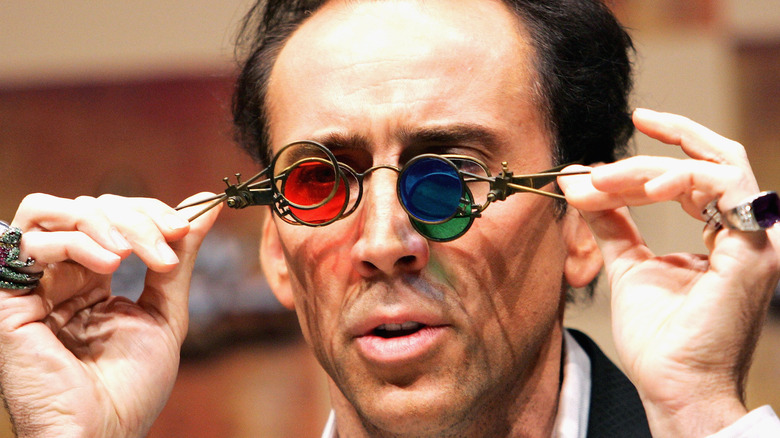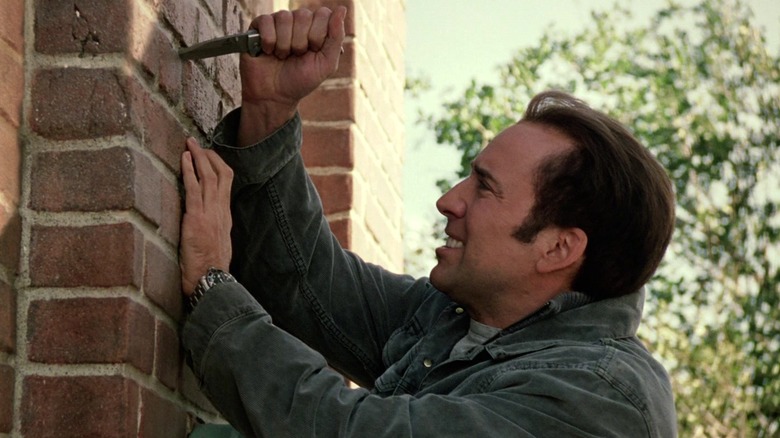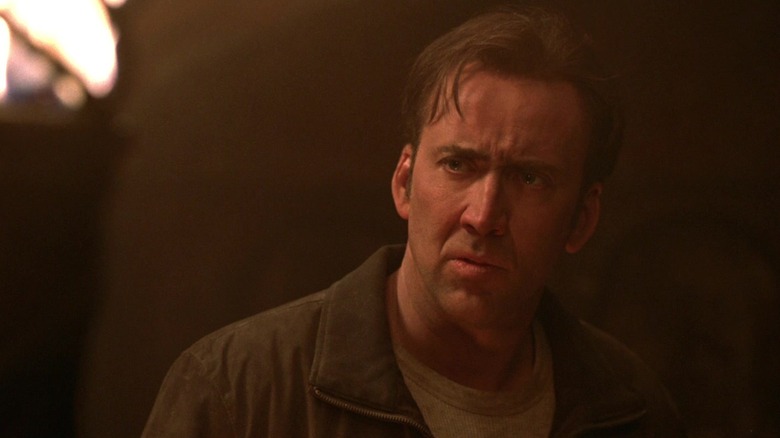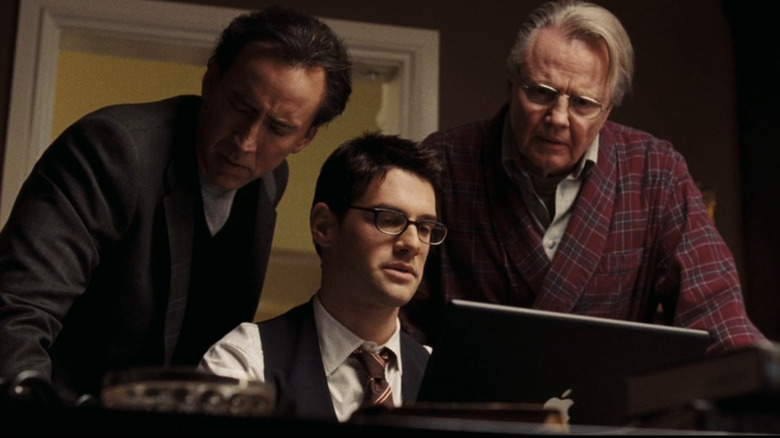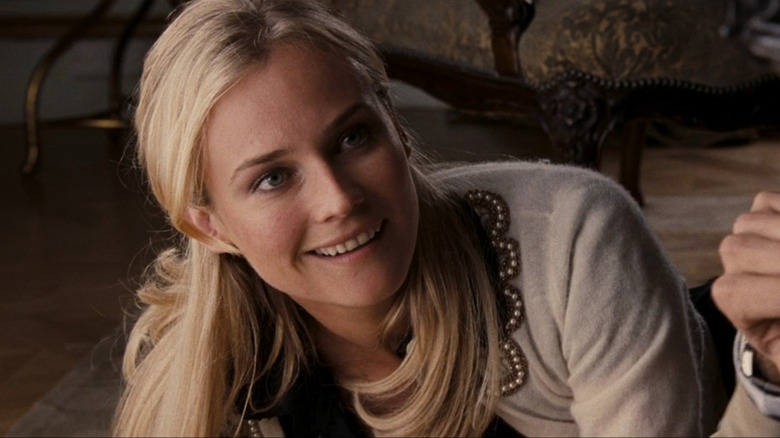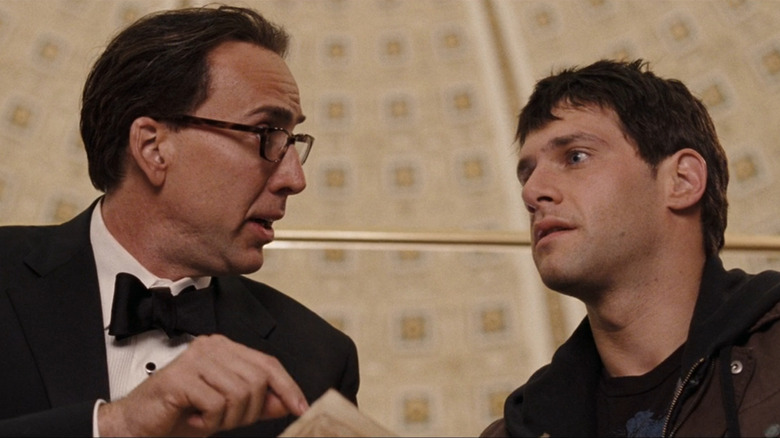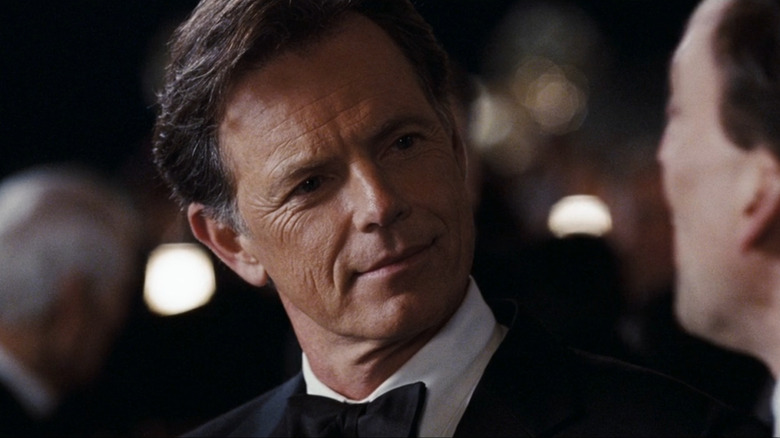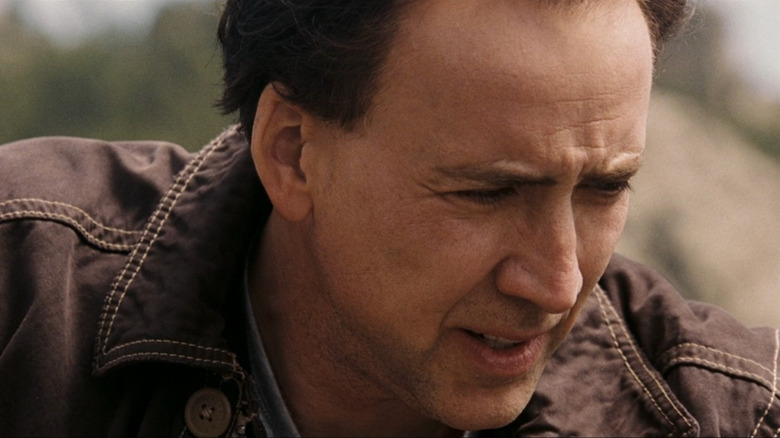The Biggest Plot Holes In The National Treasure Franchise
When "National Treasure" was released in 2004, it became a certified hit, grossing over $347 million in worldwide box office receipts. Three years later, its sequel performed even better, earning over $110 million more than its predecessor. Both films are high-energy, family-friendly action thrill rides dealing with historical fortunes hidden within American folklore, blending stunt work and chase scenes with a deep dive into United States history. From events surrounding the American Revolution and the signing of the Declaration of Independence to the plot nearly 90 years later to assassinate Abraham Lincoln to the eventual sculpting of Mount Rushmore that was conceptualized in 1925 and completed on the cusp of our entry into World War II, the films encompass the bulk of the country's past and stop short of what even most older moviegoers would consider "modern" history.
There's an advantage to this, of course, in that no one from the time is still alive to dispute the details of the treasure hunt when the filmmakers play a little fast and loose with the facts for the sake of the story. Obviously, a certain amount of dramatic license is to be expected, and there is no real consensus on how much historical accuracy is required or even possible in serious dramas, much less action movies, but that doesn't mean the "National Treasure" franchise lacks some glaring plot holes and historical inaccuracies. Let's take a look at the major ones!
George Washington didn't have campaign buttons
When Ben (Nicolas Cage) and Riley (Justin Bartha) first meet Abigail (Diane Kruger), Ben points out that she has a collection of "George Washington's campaign buttons," but is "missing the 1789 Inaugural." This sounds very impressive and not at all made up, but in reality Washington didn't have campaign buttons. It's true that there were several commemorative buttons made to celebrate his inauguration as the first president of their newly established country, but these would all be considered "1789 Inaugural" in that case, and none of them were an official product of either the government or Washington himself.
There were no campaign buttons, as we think of them. In fact, there was no campaign at all, nor was there anyone interested in challenging him. Washington stood for election alone, unopposed, and was unanimously named president twice. When in his career he did campaign for office, to the House of Burgesses in Virginia back in the 1750s, he won by swinging the voters with booze.
Lemon juice would not reveal invisible ink
After procuring the Declaration, Ben and Abigail set about attempting to reveal the invisible message on the back. To do this, they swab the area with lemon juice, then heat it as a reactivating agent. This process is actually a mishmash of two different methods for revealing invisible inks and, used together, would likely make the hidden information unreadable at best, or destroy the document at worst.
Lemon juice, while possible to use as a developer of certain chemical inks because of its high acidic quality, actually is better suited as an invisible ink itself. To reveal the message written in the lemon juice, heat it up. This will turn the writing brown, and it will not fade back to invisible again. By dabbing lemon juice all over the back corner of the Declaration of Independence, therefore, Abigail and Ben would have achieved nothing more than a dark brown splotch on the parchment, as well as an obfuscation of whatever message may have been there.
The time on the portrait of Independence Hall is what, exactly?
The trio follows the Silence Dogood letters to a clue about the Liberty Bell and Independence Hall, determining that there's a specific time for them to visit, at which point the sun will cast a Very Important Shadow that will lead them to the next step, the next clue. Ben remembers that the back of the $100 bill features a reprinted miniature of a painting of Independence Hall, looks through a water bottle acting as a magnifier, and reads the time as 2:22. However, according to the Federal Bureau of Engraving and Printing, within the Department of the Treasury, the time reflected on $100 bank notes circulating in 2004 was approximately 4:10. Funnily enough, those two times will look similar to each other on a standard analog clock face. Additionally, in a tiny reproduction of a painting, it would be nearly impossible to tell which is the minute hand, but the sheer uncertainty inherent in the question would make it difficult to state definitively what time the Important Shadow will be cast.
Moreover, in the 1700s there was no standardized time. Every locality decided what time it was based on the position of the sun in the sky, and since the sun changes position, angle, height, and arc throughout the year as the Earth rotates and revolves around it, our intrepid heroes would have had to know not only the correct time of day according to the sun's position, but the correct time of year as well, in order to find their next object's hiding spot.
Actually, the hiding spot wouldn't have been there
In 1776, when the Declaration of Independence was written and, according to "National Treasure," an elaborate Freemasons cipher and map were included on the back of the document in invisible ink, Independence Hall had no clock. No big deal, right? It still had a steeple. The clock came later (in 1828), and then the painting of Independence Hall's clock tower was just a reference made after the fact to let people know the appropriate time that the shadow was being cast by said steeple. Oh, except the original steeple was demolished in 1781.
When it was rebuilt in 1828, with the aforementioned clock, it stood significantly higher than the previous one to house both the clockworks and the bell. So assuming the hiding spot and its contents weren't accidentally destroyed in 1781 when the original steeple went down (it's hard to tell how far down from the tower Ben goes to the hiding spot, but it's still up on the roof), it would've been in whatever location the older, shorter steeple indicated, not this taller one.
No pocket knives at historical landmarks, please
As anyone who's gone to a single large-scale public event, government building, or airport in the past 20 plus years knows, security has gotten kind of relentless. Since 9/11, metal detectors and wand-wielding guards await around seemingly every corner, ready to confiscate all your high-volume liquid contraband. Pocket knives, it shouldn't need to be said, are obvious no-nos and will not pass the mandatory security screening everyone is subject to upon entering the building.
Independence Hall and the surrounding grounds are actually part of the National Park Service, which does not allow knives that constitute weapons inside national monuments. (Ben's knife absolutely meets the standard of weapon and would be banned under federal law.) There's no denying it looks cool when Ben whips out his switchblade like he's Riff in "West Side Story," but maybe he could've used something that raises fewer red flags at security checkpoints.
The Knights Templar plus Freemasons does not equal boundless loot
Frequently throughout "National Treasure," and again in its sequel, the treasure Ben and friends are seeking is referred to as the Templar treasure, relating to the Knights Templar. However, the architects of this map and elaborate treasure hunt are supposedly the Freemasons, tasked with hundreds of years of keeping the secret safe. Only, the two groups had nothing to do with one another and did not exist at the same time.
The Knights Templar were just that — knights, primarily around the time of the Crusades. They lost control of Jerusalem near the end of the 12th century and were dismantled in the early 14th century. The Freemasons, on the other hand, are a fraternal organization that grew from a union of bricklayers and has evolved to boast the membership of countless world leaders. Their earliest texts (about masonry) are rumored to date to the end of the 14th century, but the rumors and myths about the Freemasons being born out of the Knights Templar didn't emerge until nearly 300 years later, when a rumor was started that Oliver Cromwell founded the Freemasons based on some old Templar edict.
Moreover, even if the two groups were connected or working in consort to hide this global treasure, how on earth did they hide it for the several hundred years before the Declaration treasure map could've been orchestrated, much less get it to the American colonies — a place none of them even knew existed until over a hundred years after the end of the Templars? There are obvious Asian and African artifacts mixed into the treasure room. Even if we allow that these citizens of the Middle Ages traveled to (and plundered) these far-off locations, the odds that they took the most valuable heirlooms, hid them, and transported them across the treacherous Atlantic Ocean in secret hundreds of years later is a bit of a stretch.
The Laboulaye Lady was literally a clue ahead of her time
"National Treasure: Book of Secrets" opens with one of the most notorious moments in American history: the assassination of President Lincoln in 1865. In the film, conspirators around the assassination were working in secret to unearth a long-lost treasure that would fund the Confederacy to victory. They went to Thomas Gates (Joel Gretsch), ancestor to our intrepid leading man Benjamin Gates, for help cracking a cipher, which would lead to a clue pointing to the location of the treasure map.
When Ben and friends find the cipher and key, the coded message is Laboulaye Lady, a reference to the Statue of Liberty, specifically the one in Paris. However, while Édouard de Laboulaye did propose the idea for the Statue of Liberty in 1865, its construction didn't begin until 10 years later, and the inscription that Riley photographs from the torch of the Laboulaye Lady in France gives a date of 1876, 11 years after the Confederates would've been following clues to her. Even more impressive, that inscription reads "These twins stand resolute," referring, Ben surmises, to the Resolute Desks made from the timbers of the decommissioned H.M.S. Resolute. Only the ship wasn't dismantled — and the desks weren't made from it — until three years after the date on the torch, in 1879. Unless someone involved in this conspiracy to hide the treasure is a Time Lord, things just aren't adding up.
The Resolute Desk in the White House has no twin
The clue on Laboulaye's Lady reads, "These twins stand resolute." Ben takes this to mean the next clue can be found in one of the two Resolute Desks and tells a handy little expository anecdote of how they came about. Except it's not quite accurate. Queen Victoria did commission that desks be made from the dismantled H.M.S. Resolute, and the largest of these, called the Resolute Desk, was given to President Rutherford B. Hayes in 1880 and currently resides in the Oval Office. A smaller, lady's desk was also constructed, but not for the Queen. Rather, it was given to the widow of the man who orchestrated the ship's return to England. The one the Queen kept (yes, there was a third), is little more than a writing table as featured in the movie, though not a twin of the one in the White House.
The Incan civilization never established a written language
In "National Treasure: Book of Secrets," the hunt is on again, this time for the legendary Cibola, one of the Seven Cities of Gold. Ben and Abigail are back, and together they locate a wooden panel hidden in the Queen's desk at Buckingham Palace. The symbols on the plank are determined to be pre-Columbian — prior to the arrival of Christopher Columbus to the Americas — and Ben postulates, "Perhaps Aztec or Incan." Only the Incas never developed a written language of any sort.
They recorded knowledge and information through quipus, intricately knotted strings that told histories, legends, tax assessments, and just about every aspect of their society. The Incan Empire also never stretched north of South America and stuck primarily to the areas on and around the Andes Mountains. Seeing as Ben's mother (Helen Mirren) is an expert in pre-Columbian civilizations, it wouldn't be unreasonable to expect that know-it-all Benjamin Franklin Gates would have at least a basic understanding of the area.
When Ben's father Patrick Gates (Jon Voight) says the plank mentions Cibola, they do reassess their estimate and suggest that the plank is Olmec, a proto-Mayan civilization, which makes slightly more sense, as the Olmec civilization had developed some form of writing (via Science). But that still doesn't explain how a map to a city that was never found was carved into wood in a written language the builders of the city didn't use. And those builders? According to the location in the Black Hills and the visit to the city by Esteban, the most likely candidates are the Arikara tribe, an offshoot of the Pawnee, but their structures were made primarily of mud, not elaborate balance puzzles.
The President has no reason to keep up the kidnapping story
After gaining illicit access to the Oval Office and finding the second piece of the ancient treasure map missing, Ben decides his only viable move is to kidnap the president (as one does). To this end, the team forces the White House to arrange the president's (Bruce Greenwood) birthday party at Mount Vernon by booking up every other suitable venue, as if any one of them wouldn't bump some nobody for the president. Anyway, the party is at Mount Vernon, and Ben crashes the party, gets next to the President (easy as pie), and convinces him to come down into a cellar looking for a secret passage (conveniently marked with huge symbols associated with George Washington).
Repeatedly, the President asks his secret service detail to back off and give him space as he willingly follows Ben into the depths. When the two are eventually trapped, and the secret service freaks out, the President, too, is rightfully angry. Only Ben doesn't hold him there — he escorts him to the exit while explaining what he's looking for. The president eventually tells him the location of his secret book, and the two part ways in the woods not far from the party. At this time, the secret service is still frantically looking for the president and presumably the man who absconded with him, but the president could disabuse them of that notion right away. Instead, he leaves Gates with the statement, "Two hundred people know you held me against my will. I can't tell them why." Okay, but couldn't he tell them something akin to what he eventually does, that he and Gates got trapped in the passage and Gates led him out?
Literally nobody is assuming there was a secret conversation involved. In fact, by framing it as a kidnapping, it's more likely people will assume some sort of nefarious exchange of information occurred. Furthermore, he asked Ben for a favor pertaining to page 47 of the book. If the president trusted Ben enough to tell him of the existence of the book, why would he want the FBI and secret service actively tracking him down? There's no doubt someone in the president's security detail questioned the president after the incident. So why keep up the fiction that he was ever in danger?
Where did this map come from, exactly?
According to "National Treasure: Book of Secrets," in 1865 (and '76 and '79, as mentioned), people were disseminating, and in some cases creating, clues to the lost city of Cibola, the city of gold. The question is, why? In the first movie, the motive for hiding the treasure is that the Freemasons believed no one person or government should have access to all that wealth and power. That's not the case in this movie.
Supposedly, the sequel tells us, the Knights of the Golden Circle are working in consort with Queen Victoria to find the treasure and reestablish the Confederacy (a specious claim to start with, considering slavery was fully abolished in all of England and the British Colonies since 1833). But if they had the planks in 1865 or thereabouts (and someone must've, to hide them in the desks 14 years later), why go through the trouble of hiding them at all? Why not just go get the treasure? It's not like the British were well-known for leaving valuables where they found them.
Perhaps the planks couldn't be translated? Well, that's not the case either, because, as it's written in the President's book, when Calvin Coolidge found the plank, even only having half the map, he sent the sculptor Borglum to build Mount Rushmore and cover the landmarks. Why he wouldn't claim it for the country himself is beyond understanding, particularly when the U.S. went into the Great Depression less than a decade later. There's simply no reason for the treasure to have been hidden in this manner, or for this map to have existed at all without someone claiming it sometime in the past several hundred years. Basically, the entire premise of the movie is flawed. The "National Treasure" series is still a fun watch, though.
